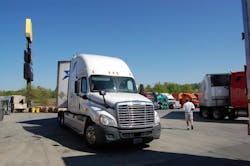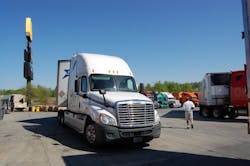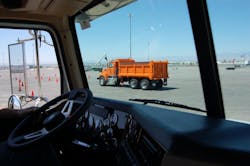Now, a lot of folks within – and without – the industry rightfully note that the low pay and long hours of the typical irregular route truckload driver are major turn-offs (putting it VERY mildly) in terms of recruiting a new generation of folks willing to pilot big rigs for a living.
Just check out this story in the Niagara Gazette newspaper; while the paper notes that truck driver jobs are plentiful, the average starting pay is just a shade over $39,000, according to Labor Department data – certainly not the kind of income that can stand alone to support a family of four these days.
Those are just some of the issues Gordon Klemp, president and founder of the National Transportation Institute (NTL), touched on during a conference call organized by Wall Street investment firm Stifel Nicolaus last week.Klemp’s consulting firm, by the way, specializes in driver compensation data, but his perspective on the driver shortage is very interesting, to say the least.
For example, in a previous discussion I had with him, Klemp pointed out to me that many drivers who lost jobs during the Great Recession found that combining unemployment checks with off-the-books cash work – such as landscaping – could in many cases equal the trucking pay they used to receive, without having to be away from home and family for weeks at a time.
Indeed, Klemp touched on that very same issue in his conference call for Stifel last week as well. For instance, here are some of the reasons why he believes the driver shortage is becoming more severe:
- Generous unemployment benefits (99 weeks) currently available to Americans;
- The burgeoning “underground economy” which provides tax free income resulting from part-time work mowing lawns, plowing snow, etc.;
- The evolution of stricter driver hiring criteria (relating to health, safety record, substance abuse history, etc.);
- The intrusion of technology into the cab, which has the net effect of pushing away drivers who are uncomfortable with the “big brother effect” created by this technology;
- The aging driver population has created a scenario where more older drivers retire or leave for health reasons than are added from driver training schools
- The expansion of private fleets, which offer more regular routes, more home time, and greater annual compensation.
“Clearly not enough younger workers are being attracted to an industry which does not pay all that well, which requires a lot of time away from home, and which requires you to buy your own meals and other personal items while on the road,” Klemp said.
Another potential problem revolves around construction activity, for if construction demand continues to climb – such as new housing starts – that could exacerbate the driver shortage further, he explained.
“Many construction workers became truck drivers when the housing construction industry tanked in 2006,” Klemp added. “As the housing industry comes back to life, some drivers may elect to rejoin the construction industry as the pay is generally as good or better and home time is typically dramatically improved.”
One way many carriers are trying to solve the driver shortage problems is by returning to the old industry practice of opening in-house driver training schools.“Carriers will invest between $1,000 and $5,000 in a driving candidate in order to properly train either him or her,” he said. “In exchange for the training, drivers increasingly are being asked to sign contracts that lock them in to the carrier that trained them – typically an eight to 12 month period. Then the rest of the industry is effectively free to poach [them].”
Another issue revolves around the ranks of owner-operators, who Klemp said are not being formed the “old fashioned” way. Instead, carriers are taking company drivers and offer to help the finance the acquisition of his or her own truck – often a used vehicle coming out of the carrier’s fleet.
“These owner-operators typically operate within the system that created them but are often not good candidates to run in traditional owner-operator markets,” Klemp warned.
Pay, though, remains the heart of the matter, he pointed out. “Dry van company driver pay rates have just returned to 2006/2007 levels as measured in current dollars,” he explained. “Yet after taking into account inflation and higher taxes, most drivers’ purchasing power has not returned to where it was six or seven years ago.”Indeed, driver wages in 2012 ranged from $37,400 per year (25th percentile) to $57,939 per year (75th percentile), with carriers across the range of pay report difficulty in recruiting and retaining drivers. By contrast, Klemp said annual average compensation for refrigerated drivers sits about $1,000 per year ahead of the average annual compensation for their dry van counterparts, with flatbed driver pay exceeding refrigerated carrier pay by about $1,000 per year.
“Refrigerated and flatbed drivers command the higher pay due to the higher percentage of live loading/unloading that occurs in those industry segments,” he explained. “Live loading and unloading relates to the driver having to be on duty while the trailer/platform is being loaded or unloaded.”
The problem, however, is that current freight rate trends suggest that few driver pay increases are imminent in company driver segments.
“The exceptions would be those sitting in the bottom quartile of the dry van sector, which can expect to raise mileage pay by four cents [per mile] in the not too distant future, and the flatbed sector, which could offer slight driver pay increases based on freight rate increases recently received in that sector,” Klemp noted.Another contrast: owner-operators witnessed, in some cases, big increases in mileage rates in late 2012 and into early 2013 as carriers became more enamored with independents as they bring what Klemp calls “the capital to the party.”
As such, he said, carriers are willing to increase pay rates by upwards of 10 cents per mile in order to entice independents to join their fleet.
Another interesting change is the development of regional pay, performance-based pay, and length of haul-based pay schemes across the industry.
“The gap in mileage pay for owner-operators and company drivers can vary by as much as eight cents per mile from the northeast to the far west,” Klemp pointed out. “Longer lengths of haul can carry higher mileage rates for company drivers and owner-operators in order to compensate drivers for time away from home. Furthermore, an increasing number of carriers are offering performance pay in exchange for productivity, safety, on-time performance, fuel efficiency, etc.”Along those lines, sign-on bonuses are again becoming “all the rage” across the industry, said Klemp. “Companies are offering solo drivers anywhere from $250 to $5,000 to join their labor force,” he noted. “Team drivers are in even higher demand and are routinely offered $5,000 to $7,000 bonuses. In one case, a carrier was, for a thirty day period, offering $15,000 signing bonuses for teams. In some cases, bonuses are not offered system-wide, rather they are offered in a particular region to solve a customer’s capacity issues.”
Yet Klemp stressed something critical where “performance bonuses” are concerned: they are most effective when drivers receive real-time feedback with respect to how they are doing vis-à-vis their bonus thresholds.
“This gives drivers’ time to alter their behavior as the month wears on, so that bonuses can still be achieved even if they seem unlikely early in the month,” he explained. “Another way to increase productivity and the effectiveness of performance bonuses is to properly align the performance bonus of the dispatcher/fleet manager and the drivers.”
Wow – is that a lot to chew on or what? Yet when it comes to finding and keeping the drivers needed to haul freight for our nation, such figurative mastication will be a dominant requirement for addressing the issues on trucking's menu for some time to come.







